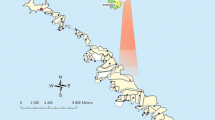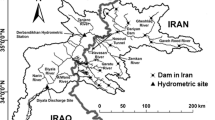Abstract
The snow pack of Sierra Nevada, southern Spain, melts during spring and early summer, feeding ancestral irrigation channels in the region known as the Alpujarra. This simulation study compares the traditional irrigation water supply, based on proportional division, with the actual supply, based on up-downstream priority, in one watershed in the Alpujarra. A combination of three models was used for the analysis. Water supply was simulated using the snowmelt-runoff model. The snow cover required by that model was determined using satellite images. A second model simulated the distribution of water based on proportional division and on up-downstream priority. Irrigation requirements and return flows were simulated using a soil–water balance. Proportional division is an inherently equitable mechanism for distributing water, but can lead to water deficits for different crops in a command area. The analysis demonstrated this premise not be true. The superiority of proportional division was magnified in dry years. Because of the internal reuse of return flows, irrigation consumptive use coefficient (the ratio of irrigation water that is evapotranspirated by the crops to the total amount of irrigation water that leaves the area of concern during the period of analysis) at the watershed scale was significantly greater than at the irrigation-channel scale. This result illustrated, based on tradition in ancestral irrigation community, the notion of integrated water resources management.










Similar content being viewed by others
References
Allen RG, Pereira LS, Raes D, Smith M (1998) Crop evapotranspiration—guidelines for computing crop water requirements. Irrigation and drainage paper 56. FAO, Rome, Italy
Berbel J, Mateos L (2014) Does investment in irrigation technology necessarily generate rebound effects? A simulation analysis based on an agro-economic model. Agric Sys 128:25–34
Bhutta MN, Kijne JW (1992) Application of a hydraulic model for testing management decisions at distributary level. Irrig Sci 13:15–20
Bishop AA, Long AK (1983) Irrigation water delivery for equity between users. J Irrig Drain Eng ASCE 109:349–356
Burt CM, Clemmens AJ, Strelkoff TS, Solomon KH, Bliesner RD, Hardy LA, Howell TA, Eisenhauer DE (1997) Irrigation performance measures: efficiency and uniformity. J Irrig Drain Eng ASCE 123:423–442
Clemmens AJ, Allen RG, Burt CM (2008) Technical concepts related to conservation of irrigation and rainwater in agricultural systems. Water Resour Res. doi:10.1029/2007WR006095
Dagnino M, Ward FA (2012) Economics of agricultural water conservation: empirical analysis and policy implications. Int J Water Resour D 28:577–600
Doorembos J, Pruitt WO (1977) Crop water requirements. Irrigation and drainage paper 24. FAO, Rome, Italy
FAO (1998) World reference base for soil resources. World soil resources report 84, FAO, Rome
Frederiksen HD, Allen RG (2011) A common basis for analysis, evaluation and comparison of offstream water uses. Water Int 36:266–282
Gavilán P, Estévez J, Berengena J (2008) Comparison of standardized reference evapotranspiration equations in Southern Spain. J Irrig Drain Eng ASCE 134:1–12
Gleick PH, Christian-Smithb J, Cooleyc H (2011) Water-use efficiency and productivity: rethinking the basin approach. Water Int 36:784–798
Glick TH (1970) Irrigation and society in medieval Valencia. Harvard University Press, Cambridge
Glick TF (2006) Irrigation in Medieval Spain: a personal narrative across a generation. In: Marcus J, Stanish C (eds) Agricultural strategies. Cotsen Institute of Archaeology, University of California, Los Angeles, pp 162–187
Gómez-Landesa E, Rango A (2002) Operational snowmelt runoff forecasting in the Spanish Pyrenees using the snowmelt runoff model. Hydrol Process 16:1583–1591
Gomez-Landesa E, Rango A, Bleiweiss M (2004) An algorithm to address the MODIS bowtie effect. Can J Rem Sens 30:644–650
Gorantiwar SD, Smout IK, Vairavamoorthy K (2006) Performance-based optimization of land and water resources within irrigation schemes. I: methods. J Irrig Drain Eng ASCE 132:332–341
Guillet D (2006) Rethinking irrigation efficiency: chain irrigation in Northwestern Spain. Hum Ecol 34:305–329
Hargreaves GH, Samani ZA (1985) Reference crop evapotranspiration from temperature. Trans ASAE 1:96–99
Huffaker R (2008) Conservation potential of agricultural water conservation subsidies. Water Resour Res. doi:10.1029/2007WR006183
Kalu IA, Paudyal GN, Gupta AD (1995) Equity and efficiency issues in irrigation water distribution. Agr Water Manag 28:335–348
Keller AA, Keller J, Seckler D (1996) Integrated water resource systems: theory and policy implications. Res rept no 3 International Water Management Institute, Colombo, Sri Lanka
Maass A, Anderson R (1978) And the desert shall rejoice: conflict, growth and justice in arid environments. MIT Press, Cambridge
Malano H, Burton M (2001) Guidelines for benchmarking performance in the irrigation and drainage sector. International Programme for technology and research in irrigation and drainage (IPTRID). FAO, Rome
Martin DL, Stegman EC, Fereres E (1990) Chapter 7: Irrigation scheduling principles. In: Hoffman GJ, Howell TA, Solomon KH (eds) Management of farm irrigation systems, American Society of Agricultural Engineers. St. Joseph, MI, pp 153–203
Martinec J (1975) Snowmelt-runoff model for stream flow forecast. Nord Hydrol 6:145–154
Martinec J, Rango A, Roberts R (2008) SRM snowmelt-runoff model user’s manual. WinSRM version 1.11. New Mexico State University, Las Cruces, NM, USA. http://www.mastergardeners.nmsu.edu/pubs/research/water/srmspecrep100.pdf
Mateos L (2008) Identifying a new paradigm for irrigation system performance. Irrig Sci 27:25–34
Mateos L, Young CA, Wallender WW, Carlson HL (2000) Simulating spatially distributed water and salt balances. J Irrig Drain Eng ASCE 126:288–295
Mateos L, López-Cortijo I, Sagardoy JA (2002) SIMIS: the FAO decision support system for irrigation scheme management. Agr Water Manag 56:193–206
Mateos L, Vivas G, Giráldez JV, González-Dugo MP (2007) Origin, tradition and decline of the ancestral irrigation systems in the high Alpujarra, Spain. ICID 22nd European regional conference, 2–6 September 2007, Pavia, Italy (CD-ROM Version)
Molden DJ, Gates TK (1990) Performance measures for evaluation of irrigation-water-delivery systems. J Irrig Drain Eng ASCE 116:804–823
Molden DJ, Sakthivadivel R, Perry CJ, de Fraiture C, Kloezen WH (1998) Indicators for comparing performance of irrigated agricultural systems. Research report 20, International Water Management Institute, Colombo, Sri Lanka
Perry C (1999) The IWMI water resources paradigm–definitions and implications. Agr Water Manag 80:45–50
Proyecto LUCDEME (1993) Mapa de Suelos 1:100000, Lanjarón-1042 (1:50000). ICONA (MAPA), Dpto. Edafología (Universidad de Granada), Madrid, Spain
Pulido-Bosch A, Ben Sbih Y (1995) Centuries of artificial recharge on the southern edge of Sierra Nevada (Granada, Spain). Environ Geol 26:57–63
Qureshi ME, Schwabe K, Connor J, Kirby M (2010) Environmental water incentive policy and return flows. Water Resour Res 46:W04517. doi:10.1029/2008WR007445
Riedener E, Rusterholz H-P, Baur B (2014) Land-use abandonment owing to irrigation cessation affects the biodiversity of hay meadows in an arid mountain region. Agric Ecosyst Environ 185:144–152
Roa-García MC (2014) Equity, efficiency and sustainability in water allocation in the andes: trade-offs in a full world. Water Altern 7:298–319
Sharma DN, Oad R (1990) Variable-time model for equitable irrigation water distribution. Agr Water Manag 17:367–377
Small LE, Rimal A (1996) Effects of alternative water distribution rules on irrigation system performance: a simulation analysis. Irrig Drain Syst 10:25–45
Smout IK, Gorantiwar SD (2006) Productivity and equity of different irrigation schedules under limited water supply. J Irrig Drain Eng ASCE 132:349–358
Steiner RA, Walter MF (1992) The effect of allocation and scheduling rules on equity and productivity in irrigation systems. Agr Water Manag 21:297–312
Trillo San José C (2004) Agua, Tierra y Hombres en Al-Andalus. La Dimensión Agrícola del Mundo Nazarí. Ajbar, Granada (Spain). In Spanish. http://www.ugr.es/~ctrillo/aguatierrahombre.pdf
Trillo San José C (2005) A social analysis of irrigation in Al-Andalus: Nazari Granada (13th–15th centuries). J Mediev History 31:163–183
US Bureau of Reclamation (1967) Canals and related structures. Design standards # 3. U.S. Department of the Interior, Bureau of Reclamation, Office of Chief Engineer, Denver, Colorado
Vanderlinden K, Giráldez JV, Van Meirvenne M (2004) Assessing reference evapotranspiration by the Hargreaves method in Southern Spain. J Irrig Drain Eng ASCE 130:184–191
Ward FA, Pulido-Velázquez M (2008) Water conservation in irrigation can increase water use. PNAS 105:18215–18220
Acknowledgments
We acknowledge the contribution of Dr. M. P. González-Dugo during the initial phase of this study and Dr. E. Gómez-Landesa for his invaluable assistant in applying SRM.
Author information
Authors and Affiliations
Corresponding author
Additional information
Communicated by E. Bautista.
Rights and permissions
About this article
Cite this article
Vivas, G., Giráldez, J.V. & Mateos, L. Water management in an ancestral irrigation system in southern Spain: a simulation analysis. Irrig Sci 34, 343–360 (2016). https://doi.org/10.1007/s00271-016-0507-7
Received:
Accepted:
Published:
Issue Date:
DOI: https://doi.org/10.1007/s00271-016-0507-7




